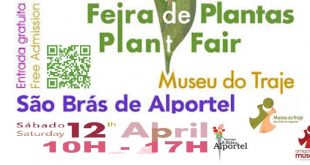The landscaping project plans for the planting of 1,000 different species of native trees and shrubs in the Barranco do Esgravatadouro valley. The first 50 young trees have been planted since 30 December: various species of oak (quercus canariensis and quercus ilex, among others), cork oak, ash (fraxinus excelsior), chestnut, walnut, beech, willow, lime, maple, birch, elm, magnolia, camellia, as well as carob, laurel and pepper-trees. The terrain has been mapped out carefully and the themes are well-defined: paths will link several islands of trees placed at different levels. The first trees have been planted along the stream that rises on the magazine publisher’s land.
At the entrance to the valley, a sign informs you of the underlying philosophy: biodiversity versus monoculture! The sign’s illustration and logo are the work of the Hamburg graphic designers Allthingsare. Many thanks to Nina Wollner and Frederik Jönssen. The cartography is by Vítor Fernandes from Loulé and the advice and technical monitoring of the project is provided by the cooperative Mushmore from Lourinhã.
Where did you get the idea of an ECO123 botanical garden?

It came from a study project, undertaken earlier this year with a group of students, teachers and parents from the Aljezur International School. The creation of the botanical garden is also an educational opportunity for putting into practice the theories taught in biology classes. Which are the Portuguese fruit trees? Which plants, condiments and herbs do we use for cooking and natural medicine?
The largest of the thematic islands focuses on the diversity of native plants and trees. Even the writer and flora expert Fernanda Botelho, well-known to television audiences, has planted an ash tree in her name at Esgravatadouro. Each tree will have a plaque stating who it was adopted by and when it was planted.
The planting of a new forest in the botanical garden at Caldas de Monchique is also linked to the KYOTO project, which aims to make a precise measurement of the ecological footprint of the 100 participants over a period of one year, in an attempt to reduce CO2 emissions to 3000 kg per person per year. Each planted tree also initiates an ecological offset for our CO2 emissions.
This is because it is not only the burning of coal, oil and gas (fossil fuels) that has led to the rise in CO2 emissions and the resulting global warming, but also the cutting down and destruction of our forests, the continuous growth of urbanised areas with the expansion of cities, and the fires that have spread across the abandoned inland regions. There’s a lot that’s wrong about the way that millions of acres of forest burn every year and there are regions where forests are sacrificed to give way to pastureland and monocultures. This is where nature is regressing and becoming unbalanced. Mixed forests are important accumulators of CO2.
Each young tree that is planted is recorded in KYOTO as a 10 kg CO2 credit. During the year in which the test will be taking place, each participant has the possibility of planting one or even more trees in the botanical garden at Esgravatadouro, thus compensating for and reducing their CO2 emissions. We are still looking for some young people, between the ages of 16 and 49, to take part in KYOTO. Anyone who is already a subscriber can take part in the game for free. After completing the registration form, we ask you to send it to info@eco123.info: and you will receive the access code for your KYOTO account (www.kyoto.eco123.info) by email.
 Eco123 Revista da Economia e Ecologia
Eco123 Revista da Economia e Ecologia

